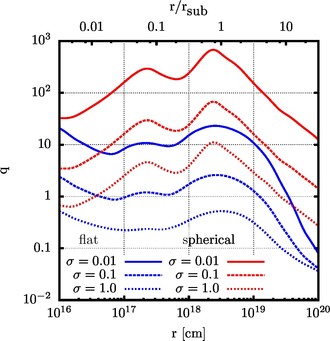
Luminous blazars are powerful radio-loud quasars with the relativistic jet pointing towards us. Typical blazar spectra consists of two main components: one peaking in the optical band and the second one in gamma-rays. The low energy component is known to be synchrotron radiation by its strong polarization. Radiation from these objects is strongly dominated by the high-energy component which is believed to originate from up-scattering of 'external radiation' by very energetic electrons accelerated inside a jet. The gamma-ray-to-synchrotron luminosity ratio is called 'Compton dominance', and is typically of the order of 10. This observation is very important as it sets certain constraints on composition and energetics of blazar jet and the surrounding quasar environment.
Blazars are among the most energetic objects in known Universe and although they have been studied for a long time, there are still some key aspects we know very little of. The key question is the location of the radiation emitting region which is often called 'the blazar zone'. Some authors claim that radiation is produced very close to the central black hole (at sub-parsec distances) while others point much farther ( > 3 pc ). Other interesting problem is the composition of a jet. It is believed that jets originate being dominated by magnetic field and are accelerated at the cost of that magnetic energy.
In paper "Magnetization of jets in luminous blazars" authors: Mateusz Janiak, Marek Sikora and Rafał Moderski of Copernicus Center, Warsaw, study the dependence of the Compton dominance parameter on the jet magnetization (the magnetic-to-matter energy flux ratio), the distance from the central black hole and two extreme cases of geometries of external photon sources (spherical and planar) which supply a jet active region with seed photons to produce gamma-rays. Theoretical models are constructed using knowledge about key radio-loud quasar parameters such as black hole mass, accretion rate or the power of the jet. Numerical models of theoretical blazar spectra are calculated for a broad range of distances from the black hole, from 0.003 pc up to 30 pc. Authors find that large values of the Compton dominance imply small jet magnetization in the blazar zone, which in turn implies that conversion from the magnetic to matter dominated jets takes place closer to the black hole than the location of the blazar zone. Typical jet magnetizations corresponding to the observed Compton dominance are of the order of 0.1 for spherical external sources and 0.01 in case of planar geometries. They also find that blazar zone cannot be located to close to the black hole at distance smaller than 0.03 pc, because of too large synchrotron peak frequency, and too far, at distances larger than 3 pc, due to decreasing with distance radiative efficiency.
Figure (from cited paper): Compton dominance (gamma-ray-to-synchroton luminosity ratio) dependence on the distance from the central black hole calculated for different jet magnetizations (the magnetic-to-matter energy flux ratios) and two cases of external photon sources geometries: spherical and flat.






